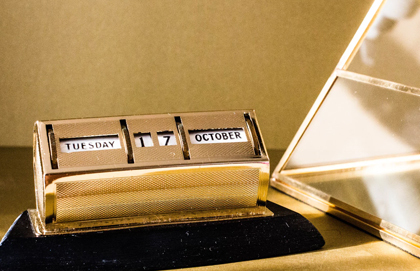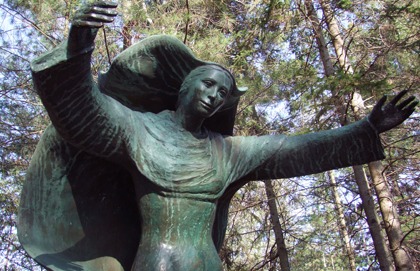It is difficult to think of a Canadian artist more praised and more polarizing than William Kurelek. His phenomenal eruption on the art scene in the 1960s and 1970s was at odds with the more dominant abstract trends of the day: his paintings were pastoral, humorous, human, even naïf
Still more unusual, they often contained religious imagery. But Kurelek—both the man and his work—was unforgettable, which is why, after a near eclipse during recent decades, the reappearance of his work in a major cross-country exhibition, William Kurelek: the messenger, bears scrutiny.
Despite sporadic dismissals as a populist—"Canada's Norman Rockwell"—or a religious ideologue, the Prairie painter has had astonishing reach. His works hang in the Museum of Modern Art in New York, the Smithsonian Institute, the National Gallery of Canada, the Art Gallery of Ontario, the Montreal Museum of Fine Arts, the personal collection of Queen Elizabeth II, and several other major museums around the world. In his lifetime, he was honoured with more than 30 national and international awards, including the Order of Canada. At least six documentary films have been made on his life and work, including a 2011 remake of The Maze, the award-winning 1970 film of the artist's troubled mental history. (The Maze features Kurelek's surrealist painting of the same name, a nightmare inside the artist's skull, created when he was a patient at London's Maudsley hospital in the 1950s. The image was also used as the cover of Van Halen's 1981 album Fair Warning.)
At least 16 books of Kurelek's stories and paintings have been published, pre-eminently his childhood memoires in the award-winning A Prairie Boy's Summer and A Prairie Boy's Winter, as well as his adult work experiences in Lumberjack. His classic A Northern Nativity is an imaginative and poignant portrayal of the Holy Family in various scenes in Canada. And his magnum opus, The Passion of Christ, is a series of 160 paintings that are housed today in the Niagara Falls Art Gallery. A simpler series of monochrome drawings depicting the 17th century Jesuit missionaries to Huronia, while unpublished, is on permanent display at the Martyrs' Shrine in Midland, Ont. Kurelek illustrated W.O. Mitchell's Who Has Seen the Wind, and Ivan Franko's Fox Mykyta. In his later years, he focused on depicting various ethnic groups in Canada, including the Inuit, the Irish, the Jews, the Poles, and his own Ukrainian pioneer people. Between his conversion to Catholicism in 1957 and his premature death at the age of 50 in 1977, Kurelek prodigiously left an estimated 2,000 paintings, scattered in innumerable collections. His works today are widely sought-after and command ever increasing prices. In 2007, Sotheby's sold his 1971 painting Manitoba Mountain for $336,000.
The recent tour of more than 80 cross-genre Kurelek paintings to three major galleries is easily the largest exhibition of his work ever launched, and the first in nearly 30 years. At the opening at the Art Gallery of Hamilton this winter, the crowd approached record levels, testifying to an enduring appreciation and perhaps new interest in the artist on the part of younger generations. Even more significantly, the exhibit, which began at the Winnipeg Art Gallery in September 2011, spent the winter in Hamilton and finishes at the Art Gallery of Greater Victoria this summer, represents an unexpected stamp of approval from the nation's art establishment. Writing in The Globe and Mail, critic Robert Enright commented that "the open-ended plurality of current art making, and a postmodern tolerance for aesthetic and personal eccentricity, make Kurelek more contemporary now than when he was alive. In 2011, he seems like a Prairie Hieronymus Bosch, his naïveté replaced by a single-minded apocalyptic vision." Kurelek, the well-seasoned chronicler of Canadiana and Christian prophet, may now be a more permanent fixture of the artistic landscape.
Indeed, the exhibit did not even pass over Kurelek's more controversial works—the "religious pro phetic" paintings he felt he was meant to make,pleading works to an indifferent age. Alongside his evocative bucolic paintings are works such as Dinnertime on the Prairies (1963), which shows an abandoned fencing job in the middle of a vast expanse of fields in which the figure of the crucified Christ hangs alone beneath empty grey skies. Kurelek's famously tormented youth informs the message here: the most casually delivered harsh word or the heedlessly indulged impure thought on a job site causes Christ to suffer again, until the end of time.
These paintings can be unabashedly didactic, and the curators wisely chose works they believed bridged both the pastoral and the prophetic. For example Our World Today (1968), depicts children playing games inside a giant barn while the roof is engulfed in flames. The allegory does not suffer from obscurity; the artist's voice seeks to appeal to people who are increasingly oblivious to impending realities. In Not Going Back to Pick Up a Cloak; If They Are in the Fields (1971), a farmer runs in terror from his plow and a hysterical team of horses as a bright orange mushroom cloud erupts on the near horizon. In The Dream of Mayor Crombie in the Glen Stewart Ravine (1974), Kurelek's social criticism becomes more explicit. The reclining Toronto mayor dreams of little supermen halting excessive urban development and putting caps on gushing smokestacks while at the same time the city collects money from a man working at a conveyor belt where doctors are carving up small infant figures.
The trajectory of Kurelek's sense of personal mission is revealed in his startlingly candid and confessional autobiography, Someone With Me.
As an adolescent, he left the family farm where his father, largely intent on the work of survival, did not understand his hypersensitive son's contemplative and artistic inclinations. William studied art at a high school in Winnipeg, displaying a natural talent that was recognized by teachers and peers, but he suffered from a sharp self-consciousness that made social interaction intensely painful. He withdrew into himself, finding refuge in bitter cynicism about the world around him. He rejected his Ukrainian Orthodox faith (although his parents had never been very religious) and came to self-identify as a sort of Joycean Romantic, a communist and an atheist.
Yet Kurelek would be drawn to a religious level of consciousness early in his life's path. One night in the 1950s, while he was hitchhiking down to Mexico, where he hoped to be admitted to an art school, he found himself sleeping under a bridge. It was a cold Arizona night, and he was curled up on the bare ground. Unsure if he was awake or asleep, he suddenly became aware that he was not alone. A figure appeared beside him and urged him to get up and continue his journey:
"He appeared to be a person in a long white robe and he was urging me to rise. 'Get up,' he was saying. 'We must look after the sheep or you will freeze to death.' I obeyed and set off at a near run down the road, shaking violently with the chill."
This experience occurred during the young artist's atheist period, and he would not understand it until his conversion seven years later. In the meantime, Kurelek would be plunged into the abyss of abandonment. The trusting youth would feel the betrayal and brunt of depersonalization from fellow artists who cultivated friendship with the ulterior motive of soliciting sexual encounters (which he resisted). His early work went unrecognized, and he began to suffer the disintegration of mental illness. Kurelek was becoming increasingly a "nobody" in the eyes of the world, an object of rejection that only later, through an understanding of the paschal mystery, would he come to see as a hard grace. This experience of suffering would teach him later to speak with authority about the mercy of God and dispose him to a deep compassion for the suffering people he encountered in the world. He would come to see that his experiences had been permitted for the sake of a greater fruitfulness and so that he would not be spiritually ruined by the fame that would later descend upon him in torrents. In his autobiography, he writes:
"To my way of thinking, the only possible explanation for the presence of evil in the universe is that it is a kind of foil. God permits suffering because He, in His omniscience, knows that the good that comes out of it in the end outweighs the evil. I know personally how true that is. It was precisely my suffering which broke through my selfishness and intellectual pride. Even on the earthly plane, it helped me become a more successful artist."
After Mexico, Kurelek journeyed to London, in part to see the European masters, and partly to seek help for his inner turmoil and crushing psychosomatic eye pain. Suffering from severe depression, he admitted himself to the Maudsley psychiatric hospital and later transferred to the Netherne Hospital, where a novel program in art therapy was being developed. The process was a long and complicated one, and included a serious attempt at suicide.
Set in these institutions, little by little, Kurelek began to find redemption. He formed a remarkable friendship with an occupational therapist and devout Catholic named Margaret Smith. He credited her with showing him that "there is something stronger than human love and human failings and passing human emotion. It is the love of God. If I could acquire that priceless strength, I, too, could face life even if it got much, much tougher." A year later, after being discharged, he met Father Thomas Lynch, a kindly English parish priest, who introduced him to the theology of Edward Holloway and to a local Jesuit scholar who could meet his growing intellectual queries regarding religious faith and who helped him come to the decision to enter the Catholic Church.
After returning to Canada, Kurelek met his future wife, Jean, in Toronto at the Catholic Information Centre, then located at the corner of Bathurst and Bloor streets. It was a place that offered both fellowship and formation, and from which groups of young adults would do urban outreach such as helping to rehabilitate prostitutes and drug addicts. William and Jean married and would raise four children together, further strengthening the course of his healing.
To interpret Kurelek's spiritual vision, one must also take into account his relationship with Madonna House, a community of priests and laity founded in the late 1940s by the exiled Russian Baroness Catherine de Hueck Doherty. Located in Combermere, a small village in the Madawaska Valley about 300 kilometres northeast of Toronto, Madonna House was a popular place for spiritual pilgrimage. The community's attention to interfaith dialogue, racial justice and radical service of the poor—as well as lay consecration of life—was ahead of its time in anticipating trends of the Second Vatican Council. Catherine had set up similar foundations in Harlem, Chicago and Toronto, which she called Friendship Houses, and was a friend of Catholic Worker Movement co-founder Dorothy Day and of the spiritual writer Thomas Merton. Yet Catherine's charismatic authority had been rejected by her own staff, and she had left heartbroken with her second husband, the American journalist Eddie Doherty, to start a new life in Combermere. Surprisingly, priests and lay people began to trickle north to join her rural apostolate, and Madonna House was born. Today its members, who make life promises of poverty, chastity and obedience, live in prayerful solidarity with the poor in field houses located across Canada and the world.
Then Kurelek travelled north to visit Madonna House in the winter of 1962-63, he found a spiritual home. He was introduced to Catherine in the large dining hall of the main house. The normally reserved artist opened by saying, "I'm Ukrainian. And I'm a believer. But there's a lot wrong with the Church. I don't think the Church is what it should be." As a Catholic, Kurelek had no problem with Church teaching, but he keenly felt the lukewarmness and compromise of many of his fellow Christians. Catherine would agree, replying, "Christ is in agony until the end of the world."
during the visit, a priest of the community offered to give Kurelek a tour of the grounds. When they entered a poustinia—a hermitage in the Russian Orthodox tradition—Kurelek saw a print of the flagellated Christ on the wall. He looked intensely at the image, then fell on his knees and broke into sobs. When his weeping had subsided, he remained kneeling for some time, gazing at the image with rapt attention and an inner calm. It was a moment of rare grace. For Madonna House, a poustinia is a place of spiritual emptying (the word literally means desert) where one is forced to confront "one's imagination, one's dreams, plans, desires, needs," anything that might hinder communion with God, in order to access a deep silence that is "but the speech of the Lord," as Catherine herself wrote. Kurelek depicts himself in a poustinia in a 1965 painting he titled simply The Hope of the World.
The final lines of his autobiography reveal the peace Kurelek finally achieved. "What I am sure of," he wrote, "is that I am not really alone anymore in the rest of my journey through this tragic, puzzling, yet wonderful world. There is someone with me and always has been. And He has asked me to get up because there is work to be done."
Kurelek purchased a small farm across the river from Madonna House in 1973 as a place where he could bring his family from time to time and escape from the city. On the property was a steep hill overlooking the valley, and on its rock face he painted a six-foot-high Byzantine Cross, a sign of reconciliation and redemption. In the late 1980s, I hiked that hill with my father (the property was purchased by Madonna House after the artist's death) to assist him as he repainted the fading Cross. He has returned every 10 years or so to repeat the act, a tribute and debt of gratitude to both Doherty and Kurelek, who nourished his own vocation as a religious artist. Jean Kurelek later gave my father her late husband's accordion, and the instrument has served as a symbol of Kurelek's life and friendship.
William Kurelek saw both the music and the discord in the world, its heights of rapture as well as its greatest depths of despondency. He was a witness to the extremes of human folly and joy, and to the terrible beauty of existence. His message is ultimately one of hope, but hope offered through the lens of the Cross. As such, he will probably always remain a sign of contradiction. He would likely agree this was part of the task he was commissioned to fulfill.






